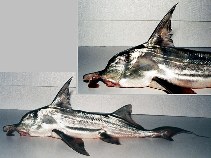Callorhinchus callorynchus (Linnaeus, 1758)
Plownose chimaera
Add your observation in Fish Watcher
| Native range | All suitable habitat | Point map | Year 2050 |

|
| This map was computer-generated and has not yet been reviewed. |
| Callorhinchus callorynchus AquaMaps Data sources: GBIF OBIS |
Upload your photos and videos
Pictures | Google imageCallorhinchus callorynchus
Picture by Martins, I.A.
Pictures | Google imageCallorhinchus callorynchus
Picture by Martins, I.A.
Uruguay country information
Common names:
Elephant fish, Gallo, Pexe gallo
Occurrence: native
Salinity: marine
Abundance: | Ref:
Importance: | Ref:
Aquaculture: | Ref:
Regulations: | Ref:
Uses: no uses
Comments: Also Ref. 58839.
National Checklist:
Country Information: https://www.cia.gov/library/publications/resources/the-world-factbook/geos/uy.html
National Fisheries Authority:
Occurrences: Occurrences Point map
Main Ref: Menni, R.C., R.A. Ringuelet and R.H. Aramburu, 1984
National Database: Dinara
Occurrence: native
Salinity: marine
Abundance: | Ref:
Importance: | Ref:
Aquaculture: | Ref:
Regulations: | Ref:
Uses: no uses
Comments: Also Ref. 58839.
National Checklist:
Country Information: https://www.cia.gov/library/publications/resources/the-world-factbook/geos/uy.html
National Fisheries Authority:
Occurrences: Occurrences Point map
Main Ref: Menni, R.C., R.A. Ringuelet and R.H. Aramburu, 1984
National Database: Dinara
Common names from other countries
Classification / Names Nombres comunes | Sinónimos | Catalog of Fishes(Género, Especie) | ITIS | CoL | WoRMS | Cloffa
Holocéfalos (quimeras) (chimaeras) > Chimaeriformes (Chimaeras) > Callorhinchidae (Plownose chimaeras)
Etymology: Callorhinchus: Tautonymous with Chimaera callorynchus Linnaeus 1758 (but unnecessarily emended from -rynchus to -rhinchus: callum (L.), hard skin; rhynchus (L.), snout, referring to peculiar hoe-shaped proboscis (See ETYFish); callorynchus: callum (L.), hard skin; rhynchus (L.), snout, referring to peculiar hoe-shaped proboscis (See ETYFish).
More on author: Linnaeus.
Etymology: Callorhinchus: Tautonymous with Chimaera callorynchus Linnaeus 1758 (but unnecessarily emended from -rynchus to -rhinchus: callum (L.), hard skin; rhynchus (L.), snout, referring to peculiar hoe-shaped proboscis (See ETYFish); callorynchus: callum (L.), hard skin; rhynchus (L.), snout, referring to peculiar hoe-shaped proboscis (See ETYFish).
More on author: Linnaeus.
Environment: milieu / climate zone / depth range / distribution range Ecología
marino demersal; rango de profundidad 10 - 116 m (Ref. 34015). Subtropical; 5°C - 10°C (Ref. 34015); 3°S - 56°S, 82°W - 43°W
Distribución Países | Áreas FAO | Ecosistemas | Ocurrencias, apariciones | Point map | Introducciones | Faunafri
Southeast Pacific and Southwest Atlantic.
Tamaño / Peso / Age
Maturity: Lm ? range ? - ? cm
Max length : 89.2 cm SL macho / no sexado; (Ref. ); common length : 70.0 cm TL macho / no sexado; (Ref. 6077)
Max length : 89.2 cm SL macho / no sexado; (Ref. ); common length : 70.0 cm TL macho / no sexado; (Ref. 6077)
Short description Claves de identificación | Morfología | Morfometría
Espinas dorsales (total) : 1. Pectorals very large (Ref. 27363).
Occurs in sandy and muddy substrates. Apparently associated with Stromateus brasiliensis and Discopyge tschudii (Ref. 34015). Oviparous (Ref. 50449). Max length (Itamar Alves Martins, pers. comm., 2002).
Life cycle and mating behavior Madurez | Reproducción | Puesta | Huevos | Fecundidad | Larva
Oviparous (Ref. 50449).
Main reference
Upload your references | Referencias | Coordinador | Colaboradores
Menni, R.C., R.A. Ringuelet and R.H. Aramburu, 1984. Peces marinos de la Argentina y Uruguay. Editorial Hemisferio Sur S.A. Buenos, Aires, Argentina. 359 p. (Ref. 2806)
IUCN Red List Status (Ref. 130435: Version 2024-1)
Vulnerable, ver lista roja de la UICN (VU) (A2d); Date assessed: 02 September 2019
Threat to humans
Harmless
Human uses
Pesquerías: comercial
FAO(pesquerías: producción; publication : search) | FishSource |
Más información
Trophic ecology
componentes alimenticios
Composición de la dieta
consumo de alimento
Food rations
Despredadores
componentes alimenticios
Composición de la dieta
consumo de alimento
Food rations
Despredadores
Population dynamics
Coeficiente del crecimiento para
Max. ages / sizes
Length-weight rel.
Length-length rel.
Length-frequencies
Mass conversion
Reclutamiento
Abundancia
Coeficiente del crecimiento para
Max. ages / sizes
Length-weight rel.
Length-length rel.
Length-frequencies
Mass conversion
Reclutamiento
Abundancia
Life cycle
Reproducción
Madurez
Fecundidad
Puesta
Spawning aggregations
Huevos
Egg development
Larva
Dinámica larvaria
Reproducción
Madurez
Fecundidad
Puesta
Spawning aggregations
Huevos
Egg development
Larva
Dinámica larvaria
Anatomy
Superficie branquial
Brain
Otolith
Superficie branquial
Brain
Otolith
Physiology
Body composition
Nutrients
Consumo del oxígeno
Tipo de natación
Velocidad de natación
Visual pigments
Fish sound
Diseases & Parasites
Toxicity (LC50s)
Body composition
Nutrients
Consumo del oxígeno
Tipo de natación
Velocidad de natación
Visual pigments
Fish sound
Diseases & Parasites
Toxicity (LC50s)
Genetics
Genética
Heterozygosity
heritabilidad
Genética
Heterozygosity
heritabilidad
Human related
Aquaculture systems
Perfiles de acuicultura
Razas
Ciguatera cases
Stamps, coins, misc.
Aquaculture systems
Perfiles de acuicultura
Razas
Ciguatera cases
Stamps, coins, misc.
Herramientas
E-book | Guía de campo | Asistente para frecuencias de tallas | Herramienta de ciclo de vida | Mapa de puntos | Classification Tree
| Catch-MSY |
Special reports
Download XML
Fuentes de Internet
Aquatic Commons | BHL | Cloffa | BOLDSystems | Websites from users | Check FishWatcher | CISTI | Catalog of Fishes(Género, Especie) | DiscoverLife | ECOTOX | Faunafri | Fishtrace | GenBank(genome, nucleotide) | GloBI | GOBASE | | Google Books | Google Scholar | Google | IGFA World Record | MitoFish | Bases de datos nacionales | Otolith Atlas of Taiwan Fishes | PubMed | Reef Life Survey | Scirus | SeaLifeBase | Árbol de la vida | Wikipedia(Go, búsqueda) | World Records Freshwater Fishing | Expediente Zoológico
Estimates based on models
Preferred temperature (Ref. 115969): 7.5 - 14.8, mean 11.3 (based on 125 cells).
Phylogenetic diversity index (Ref. 82804): PD50 = 0.7500 [Uniqueness, from 0.5 = low to 2.0 = high].
Bayesian length-weight: a=0.00457 (0.00219 - 0.00954), b=3.13 (2.93 - 3.33), in cm Total Length, based on LWR estimates for this species & (Sub)family-body (Ref. 93245).
Nivel trófico (Ref. 69278): 3.4 ±0.1 se; based on diet studies.
Resiliencia (Ref. 120179): Bajo, población duplicada en un tiempo mínimo de 4.5-14 años (Fec assumed to be <100).
Fishing Vulnerability (Ref. 59153): High to very high vulnerability (65 of 100).




